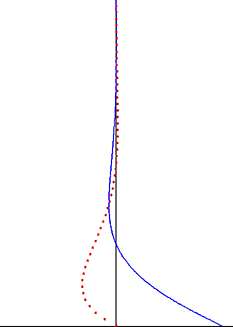Planar Couette flow

Couette flow is frequently used in undergraduate physics and engineering courses to illustrate shear-driven fluid motion. A simple configuration corresponds to two infinite, parallel plates separated by a distance ; one plate translates with a constant relative velocity in its own plane. Neglecting pressure gradients, the Navier–Stokes equations simplify to
where is the spatial coordinate normal to the plates and is the velocity field. This equation reflects the assumption that the flow is unidirectional — that is, only one of the three velocity components is non-trivial. If the lower plate corresponds to , the boundary conditions are and . The exact solution
can be found by integrating twice and solving for the constants using the boundary conditions. A notable aspect of the flow is that shear stress is constant throughout the domain. In particular, the first derivative of the velocity, , is constant. According to Newton's Law of Viscosity (Newtonian fluid), the shear stress is the product of this expression and the (constant) fluid viscosity.
Startup

In reality, the Couette solution is not reached instantaneously. The "startup problem" describing the approach to steady state is given by
subject to the initial condition
and with the same boundary conditions as the steady flow:
The problem can be made homogeneous by subtracting the steady solution. Then, applying separation of variables leads to the solution: [4]
- .
The timescale describing relaxation to steady state is , as illustrated in the figure. The time required to reach the steady state depends only on the spacing between the plates and the kinematic viscosity of the fluid, but not on .
Planar flow with pressure gradient
A more general Couette flow includes a constant pressure gradient in a direction parallel to the plates. The Navier–Stokes equations are
where is the dynamic viscosity. Integrating the above equation twice and applying the boundary conditions (same as in the case of Couette flow without pressure gradient) gives
The pressure gradient can be positive (adverse pressure gradient) or negative (favorable pressure gradient). In the limiting case of stationary plates (), the flow is referred to as Plane Poiseuille flow, and has a symmetric (with reference to the horizontal mid-plane) parabolic velocity profile. [5]
Compressible flow


In incompressible flow, the velocity profile is linear because the fluid temperature is constant. When the upper and lower walls are maintained at different temperatures, the velocity profile is more complicated. However, it has an exact implicit solution as shown by C. R. Illingworth in 1950. [6]
Consider the plane Couette flow with lower wall at rest and the upper wall in motion with constant velocity . Denote fluid properties at the lower wall with subscript and properties at the upper wall with subscript . The properties and the pressure at the upper wall are prescribed and taken as reference quantities. Let be the distance between the two walls. The boundary conditions are
where is the specific enthalpy and is the specific heat. Conservation of mass and -momentum requires everywhere in the flow domain. Conservation of energy and -momentum reduce to
where is the wall shear stress. The flow does not depend on the Reynolds number , but rather on the Prandtl number and the Mach number , where is the thermal conductivity, is the speed of sound and is the specific heat ratio. Introduce the non-dimensional variables
In terms of these quantities, the solutions are
where is the heat transferred per unit time per unit area from the lower wall. Thus are implicit functions of . One can also write the solution in terms of the recovery temperature and recovery enthalpy evaluated at the temperature of an insulated wall i.e., the values of and for which .[ clarification needed ] Then the solution is
If the specific heat is constant, then . When and , then and are constant everywhere, thus recovering the incompressible Couette flow solution. Otherwise, one must know the full temperature dependence of . While there is no simple expression for that is both accurate and general, there are several approximations for certain materials — see, e.g., temperature dependence of viscosity. When and , the recovery quantities become unity . For air, the values are commonly used, and the results for this case are shown in the figure.
The effects of dissociation and ionization (i.e., is not constant) have also been studied; in that case the recovery temperature is reduced by the dissociation of molecules. [7]
Rectangular channel


One-dimensional flow is valid when both plates are infinitely long in the streamwise () and spanwise () directions. When the spanwise length is finite, the flow becomes two-dimensional and is a function of both and . However, the infinite length in the streamwise direction must be retained in order to ensure the unidirectional nature of the flow.
As an example, consider an infinitely long rectangular channel with transverse height and spanwise width , subject to the condition that the top wall moves with a constant velocity . Without an imposed pressure gradient, the Navier–Stokes equations reduce to
with boundary conditions
Using separation of variables, the solution is given by
When , the planar Couette flow is recovered, as shown in the figure.





















































































